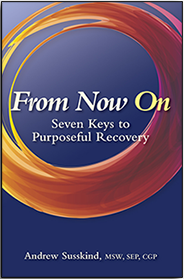Shame Resiliency
Learn how shame lives inside you, as well as your shame patterns. It’s a complicated emotion, but therapy and twelve-step work provide fertile ground to identify and heal these wounds. Read books about shame resiliency, too, and start a conversation about shame with confidants. By breaking out of isolation, you’ll take some of the power away from the shame and move toward more vulnerability and connection.
The language of shame can also be liberating. Begin to use the word “shame” to claim the emotion as a part of you. It doesn’t define you. It’s simply a part of who you are.
Reducing your shame also decreases your vulnerability to relapse, since unprocessed shame takes you out of emotional sobriety and creates a slippery slope back to self-destructive behavior. My grandmother showed me unconditional love through cooking my favorite soups, croquettes, and Eastern European cookies, as well as effusively expressing her love for me. I was fortunate that she lived close enough for me to ride my bicycle to her apartment. We would have sleepovers on a regular basis—my place for both emotional and nutritional nourishment. She provided an emotional cushion that prevented me from sinking deeper into my own shame and perfectionism. This is not to say shame wasn’t there, but her love and belief in me helped me stay buoyant.
Whatever support was or was not available to you in the past, how you approach love today will determine your healing in recovery. Out-of-control sexual behaviors have likely blocked you from receiving love in recent years, but that doesn’t mean love isn’t around you. Take inventory of the love available to you now and in the past.
Shame also manifests as a fear of abandonment. When forging new relationships, you may think: if they really knew me, would they sprint in the opposite direction? For intimacy to take shape, we have to let others get to know the real us. This is quite a bind. On the one hand, deep down you’ve always wanted to be close to others, it just always became sexualized. Emotional transparency requires gradually revealing yourself, one bit at a time.
Instead of beating yourself up for the problematic sexual behaviors of your past, take the opportunity to get to know your imperfections and see what lessons they hold. My mentors taught me how to laugh at my perfectionism and take myself less seriously. As Buddhists have shown for thousands of years, outward compassion and self-compassion are key to contented existence. Learn to be kinder and gentler to yourself, a reparenting process that requires patience and flexibility.
Because of the shame and secrecy, your sexually compulsive behavior distanced you from others, and in turn you avoided vulnerability. By taking emotional risks and pursuing wise friends, you’ll foster meaningful connection. People appreciate honesty, and we’re all inclined to sympathize with individuals who express sources of embarrassment and emotional hardship. This will lead to more intimacy in your relationships.
By practicing vulnerability you’ll share more of yourself, and others will have a chance to finally get to know the real you. This may be intimidating, but it’s the foundation to more satisfying relationships. Lean into the love around you and you’ll build the capacity to hold more love in your heart, both for yourself and others.
Turning down the volume on shame, perfectionism, and envy is not a solitary process. Sometimes it takes one person to show you the way; other times it takes a group of trusted healers.
Action Steps:
- Shame is a universal emotion that can be both helpful and destructive. Keep a shame inventory to distinguish between healthier shame and toxic shame.
- The kid inside you is looking for guidance and healing. Write a letter to your inner child asking what he or she needs from you at this stage of your recovery. Share the letter with your therapist, coach, or sponsor.
- Shame is here to stay—it’s part of being human. Track experiences when you feel more resilient to shame by describing them in a journal.
- Perfectionism perpetuates shame, and shame perpetuates isolation. Notice current examples of perfectionism and identify what purpose they might serve.
- Judgment is a form of distancing. Ask yourself what you’re protecting yourself from and what you would like to do differently the next time.




